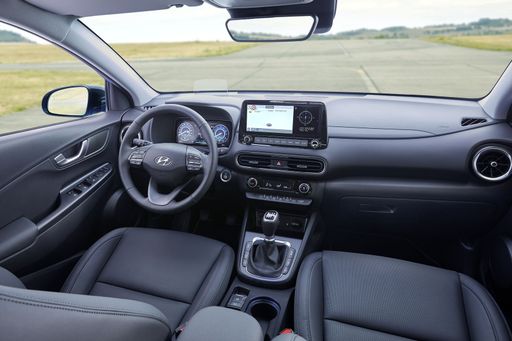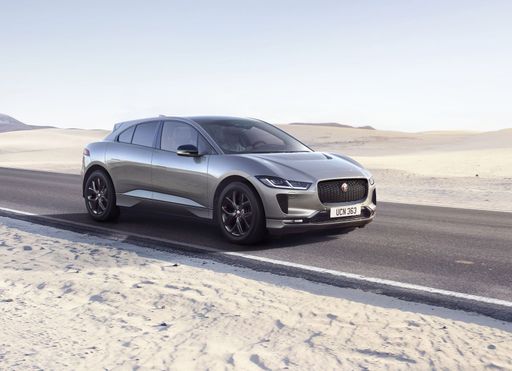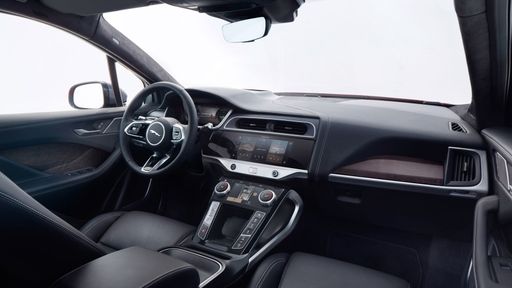Hyundai Kona vs Jaguar I-Pace – Differences & prices compared
Compare performance, boot space, consumption and price in one view.
Find out now: which car is the better choice for you – Hyundai Kona or Jaguar I-Pace?
The Hyundai Kona (SUV) comes with a Petrol, Full Hybrid or Electric engine and Manuel or Automatic transmission. In comparison, the Jaguar I-Pace (SUV) features a Electric engine with Automatic transmission.
When it comes to boot capacity, the Hyundai Kona offers 466 L, while the Jaguar I-Pace provides 638 L – depending on how much space you need. If you’re looking for more power, decide whether the 218 HP of the Hyundai Kona or the 400 HP of the Jaguar I-Pace suits your needs better.
In terms of consumption, the values are 14.60 kWh4.50 L per 100 km for the Hyundai Kona, and 25.20 kWh for the Jaguar I-Pace.
Price-wise, the Hyundai Kona starts at 23100 £, while the Jaguar I-Pace is available from 79200 £. Compare all the details and find out which model fits your lifestyle best!
Hyundai Kona
The Hyundai Kona blends a bold design with a versatile interior, making it a standout choice in the compact SUV market. Its crisp handling and responsive steering provide an engaging driving experience, whether in the city or on the open road. The vehicle also offers a range of features designed to enhance comfort and connectivity, ensuring a pleasurable journey for both driver and passengers.
details @ hyundai.news
@ hyundai.news
 @ hyundai.news
@ hyundai.news
 @ hyundai.news
@ hyundai.news
 @ hyundai.news
@ hyundai.news
Jaguar I-Pace
The Jaguar I-Pace represents a remarkable fusion of cutting-edge electric performance and iconic British luxury. With its sleek design and spacious interior, this model redefines what one can expect from an electric vehicle in terms of style and comfort. Its impressive driving dynamics and advanced technology make it a standout choice for those looking to make a statement on the road.
details @ media.jaguar.com
@ media.jaguar.com
 @ media.jaguar.com
@ media.jaguar.com
 @ media.jaguar.com
@ media.jaguar.com

|

|
|
|
|
Costs and Consumption |
|
|---|---|
|
Price
23100 - 41600 £
|
Price
79200 - 85500 £
|
|
Consumption L/100km
4.5 - 6.9 L
|
Consumption L/100km
-
|
|
Consumption kWh/100km
14.6 - 16.8 kWh
|
Consumption kWh/100km
25.20 kWh
|
|
Electric Range
377 - 514 km
|
Electric Range
469 km
|
|
Battery Capacity
1.3 - 65.4 kWh
|
Battery Capacity
84.70 kWh
|
|
co2
0 - 157 g/km
|
co2
0 g/km
|
|
Fuel tank capacity
38 - 47 L
|
Fuel tank capacity
-
|
Dimensions and Body |
|
|---|---|
|
Body Type
SUV
|
Body Type
SUV
|
|
Seats
5
|
Seats
5
|
|
Doors
5
|
Doors
5
|
|
Curb weight
1370 - 1773 kg
|
Curb weight
2226 kg
|
|
Trunk capacity
466 L
|
Trunk capacity
638 L
|
|
Length
4350 - 4385 mm
|
Length
4682 mm
|
|
Width
1825 mm
|
Width
2011 mm
|
|
Height
1580 - 1585 mm
|
Height
1566 mm
|
|
Payload
420 - 490 kg
|
Payload
444 kg
|
Engine and Performance |
|
|---|---|
|
Engine Type
Petrol, Full Hybrid, Electric
|
Engine Type
Electric
|
|
Transmission
Manuel, Automatic
|
Transmission
Automatic
|
|
Transmission Detail
Manual Gearbox, Dual-Clutch Automatic
|
Transmission Detail
Reduction Gearbox
|
|
Drive Type
Front-Wheel Drive, All-Wheel Drive
|
Drive Type
All-Wheel Drive
|
|
Power HP
100 - 218 HP
|
Power HP
400 HP
|
|
Acceleration 0-100km/h
7.8 - 13.3 s
|
Acceleration 0-100km/h
4.80 s
|
|
Max Speed
162 - 208 km/h
|
Max Speed
200 km/h
|
|
Torque
200 - 265 Nm
|
Torque
696 Nm
|
|
Number of Cylinders
3 - 4
|
Number of Cylinders
-
|
|
Power kW
74 - 160 kW
|
Power kW
294 kW
|
|
Engine capacity
998 - 1598 cm3
|
Engine capacity
-
|
General |
|
|---|---|
|
Model Year
2024
|
Model Year
2023
|
|
CO2 Efficiency Class
D, C, E, F, A
|
CO2 Efficiency Class
A
|
|
Brand
Hyundai
|
Brand
Jaguar
|
Hyundai Kona
The Hyundai Kona: A Comprehensive Overview
The Hyundai Kona has established itself as a standout in the compact SUV segment, blending innovation with performance and style. As the automotive world moves towards more sustainable and efficient options, the Kona offers a variety of powertrains, from traditional petrol engines to full hybrids and all-electric models.
Powertrain Options and Performance
The Hyundai Kona's powertrain choices cater to a wide range of preferences. For petrol enthusiasts, the Kona offers a 1.0L T-GDI engine, delivering 100 PS, and a more robust 1.6L T-GDI variant with up to 170 PS. Those looking for efficiency without sacrificing power can consider the full hybrid model, offering 129 PS and an impressive consumption of 4.5 L/100km.
For a greener option, the all-electric Kona provides a compelling case. With battery capacities of up to 65.4 kWh, the electric Kona offers power outputs of 156 to 218 PS, and efficiencies as low as 14.6 kWh/100km, enabling an electric range of up to 513 km.
Technical Specifications and Innovations
Built on a robust platform, the Kona delivers versatility and reliability. With a choice between manual or dual-clutch automatic gearboxes, along with options for front-wheel or all-wheel drive, the Kona ensures a tailored driving experience. The handling is enhanced by the car's lightweight construction, balancing a 1370 to 1773 kg curb weight with dynamic performance.
The Kona's design doesn't compromise cargo space for style; it offers a generous 466 L boot capacity. With a relatively compact body, measuring 4350 to 4385 mm in length, the Kona easily navigates urban environments while still commanding a strong road presence with its 1825 mm width.
Efficiency and Eco-Friendliness
Hyundai is committed to reducing emissions, as evidenced by the Kona's CO2 efficiency ratings, which range from class A for electric models to class D for some higher-performance petrol variants. The focus on reducing environmental impact without sacrificing driving pleasure is notable throughout the Kona range.
Costing and Value
The Hyundai Kona offers commendable value for money. Pricing starts at €26,400 and reaches up to €50,690, depending on the chosen configuration. The monthly running costs range from €956 to €1090, with a cost per kilometre of 38.3 to 43.6 cents, making it a competitive option in its class.
Conclusion: Modern, Efficient, and Versatile
The Hyundai Kona stands as a testament to Hyundai's commitment to innovation, efficiency, and practicality. Whether you are inclined towards a traditional combustion engine, a hybrid for a balance of power and efficiency, or a full electric model for maximum eco-friendliness, the Kona provides a tailored solution for each unique driver preference.
Jaguar I-Pace
Discovering Innovation: The Jaguar I-Pace
The Jaguar I-Pace represents a bold leap into the future of automotive design and engineering, blending luxury, performance, and sustainability into one stunning package. As Jaguar’s first all-electric model, the I-Pace not only showcases their commitment to innovation but also sets a new standard in the electric vehicle market.
A Powerhouse on Wheels
Under the sleek body of the Jaguar I-Pace lies an electric motor capable of delivering an impressive 400 PS (294 kW). This translates into an exhilarating driving experience, with the I-Pace accelerating from 0 to 100 km/h in just 4.8 seconds. The instant torque provided by the motor ensures unparalleled responsiveness, making every drive thrilling.
Efficient Performance
Despite its powerful performance, the Jaguar I-Pace is equally impressive in terms of efficiency. Boasting a consumption rate of just 25.2 kWh per 100 km and an electric range of up to 469 km, it’s clear that Jaguar has engineered this model to deliver uncompromised efficiency. With a noteworthy CO2 emission of 0 g/km, the I-Pace stands as a testament to the possibilities of sustainable luxury vehicles.
Advanced Engineering and All-Wheel Drive
The Jaguar I-Pace features an all-wheel-drive system, offering superior handling and stability, crucial for a vehicle with such performance credentials. The combination of dual electric motors and a sophisticated reduction gearbox enhances its prowess on the road, ensuring a smooth and responsive drive regardless of terrain.
A Design to Impress
One look at the Jaguar I-Pace, and its embodiment of modern elegance is unmistakable. With dimensions of 4682 mm in length, 2011 mm in width, and 1566 mm in height, this SUV is both spacious and stylish. The interior is equally inviting, with premium materials and high-tech features offering a luxurious driving experience for up to five passengers.
Technological Marvel
The I-Pace is packed with cutting-edge technology, from its intuitive infotainment system to its advanced safety features. The vehicle's aerodynamic design not only enhances its aesthetic appeal but also contributes to its efficiency and range, making it a marvel of modern engineering.
Sustainability Without Compromise
Jaguar positions the I-Pace as a trailblazer in eco-friendly driving, earning an A-class CO2 efficiency rating. It underscores a commitment to sustainability without compromising the luxury and performance that aficionados have come to expect from the Jaguar brand.
Conclusion
The Jaguar I-Pace is more than just an electric vehicle; it represents a future where performance, luxury, and sustainability coexist seamlessly. With its groundbreaking design and technology, the I-Pace not only captures the essence of Jaguar's rich heritage but also paves the way for the brand's journey into the electric era.
The prices and data displayed are estimates based on German list prices and may vary by country. This information is not legally binding.
